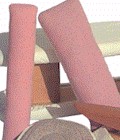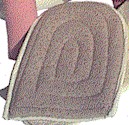The human body is not flat like an ironing board. When a tailored garment is made, the body curves are shaped into the garment for a correct fit. To accomplish various garment shapes, tailor tools and pressing techniques are used for specific garment areas. Also, pressing seams open is an important part of tailoring.
One of the differences between a home made and a fine tailored garment is in the pressing. “Pressing” is not “ironing.” In ironing, the iron is run back and forth over the fabric. In pressing, the iron is lowered onto the fabric and then lifted up from the fabric. Moisture is usually added to this process by means of a damp pressing cloth and a dry iron. After pressing, let the fabric surface cool before moving it.
One simple technique of tailoring is to press the stitching line flat. First, press the stitching line on one side of the fabric, then press it on the other side, and finally press the seam open. This is called “melding threads” and the result is a row of stitches that is hardly distinguishable from the fabric. When pressing a seam open, choose the appropriate tailoring tool or pressing surface to achieve the desired results.
A clapper/pounding block is used to flatten a seam, pleat, dart, lapel, buttonhole, etc. Place a damp press cloth over the fabric and press slightly with a dry iron. Remove the press cloth and while the fabric is still damp, press the clapper firmly onto the seam, lapel, etc. for several seconds to flatten the area. Allow fabric to dry before moving it. On soft or fragile fabric, place a press cloth between the fabric and clapper to avoid marks. Pounding a fabric is produced by holding the clapper/pounding block above the fabric surface and is forcibly dropping it onto the fabric, then raise it and drop again and again overlapping the area pounded. Pounding will flatten bulky seams and should be done on a padded surface such as an ironing board.
The pointed end of the point presser allows the pressing of seams in tight areas such as the point of a collar. Use the top flat surface of the point presser to press open any seam where a crisp, flat seam is desired.
A sleeve board is a small ironing board that is narrow enough to fit into a sleeve. It is an excellent pressing surface for small or hard-to-reach areas such as necklines and sleeve caps.
A seam roll is a two-sided cylinder, one side covered with wool and the other side covered with cotton. Using a seam roll in tight areas, such as sleeve inner seams, prevents ridges or marks from forming when you press the seam open.
The tailor ham is a rounded, padded two-sided surface used to press on. One side is wool and the other side is cotton. The oval shaped tool is used when pressing any curved surface to help shape the curve of the garment to fit the curve of the body. It is also used to retain a curve when basting, pressing, or shaping a curved section of a garment such as darts, hip line seams, sleeve caps, collar rolls, etc. Because the tailor ham is rounded and tends to roll around, place the tailor ham in a ham holder to stabilize it.
Similar to the tailor ham, the pressing mitt can be used to press a curved surface. By placing your hand inside the pressing mitt, you can support a garment area from the wrong side while steaming it from the right side. Also, the pressing mitt can be slipped over the end of the sleeve board to simulate a small tailor ham.
Place a lapel roll under the coat or jacket lapel when steaming the collar/lapel to shape it into a gentle roll.
A press cloth is a layer of fabric placed between the fabric and the iron to protect the fabric from scorching or shining. Several types and thicknesses of press cloths should be kept near your iron. A heavy-duty wool/cotton press cloth allows stem to penetrate the fabric while protecting the fabric. A light weigh press cloth simply protects the fabric as it is pressed.
Attention to pressing and using the correct tailoring tools will prevent your garments from looking home made.
Create your own tailor tools with the Professional Tailoring Tools to Make at Home pattern.
copyright © MM, C.W. Carvalho. ALL RIGHTS RESERVED. This material is not for sale or reproductions without the written consent of the author. Do not copy or post to another web site. This material is copyrighted and printed with permission and may be used for your personal use only. It may not be copied or reproduced in any form, sold, or copied or posted to another web site.






